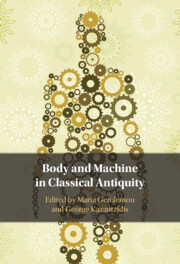Book contents
- Body and Machine in Classical Antiquity
- Body and Machine in Classical Antiquity
- Copyright page
- Contents
- Figures
- Contributors
- An Introduction to Body–Machine Intersections
- Part I Blended Bodies
- Part II The Technological Body
- Part III Towards the Mechanization of the Human Body
- Chapter 7 Aristotle on the Lung and the Bellows–Lungs Analogy
- Chapter 8 The Ill Effect of South Winds on the Joints in the Human Body
- Chapter 9 The Beauty That Lies Within
- Chapter 10 The Mechanics of the Heart in Antiquity
- Chapter 11 The Mechanics of Galen’s Theory of Nutrition
- Chapter 12 Iatromechanism and Antiquarianism in Morgagni’s Studies on Celsus, 1720–1761
- Conclusions or From Antiquity to the Early Modern
- Index of Passages
- General Index
- References
Chapter 11 - The Mechanics of Galen’s Theory of Nutrition
from Part III - Towards the Mechanization of the Human Body
Published online by Cambridge University Press: 13 July 2023
- Body and Machine in Classical Antiquity
- Body and Machine in Classical Antiquity
- Copyright page
- Contents
- Figures
- Contributors
- An Introduction to Body–Machine Intersections
- Part I Blended Bodies
- Part II The Technological Body
- Part III Towards the Mechanization of the Human Body
- Chapter 7 Aristotle on the Lung and the Bellows–Lungs Analogy
- Chapter 8 The Ill Effect of South Winds on the Joints in the Human Body
- Chapter 9 The Beauty That Lies Within
- Chapter 10 The Mechanics of the Heart in Antiquity
- Chapter 11 The Mechanics of Galen’s Theory of Nutrition
- Chapter 12 Iatromechanism and Antiquarianism in Morgagni’s Studies on Celsus, 1720–1761
- Conclusions or From Antiquity to the Early Modern
- Index of Passages
- General Index
- References
Summary
This chapter explores Galen’s ideas concerning the digestive-nutritive process. It focuses on his explanation of the motion of nutritive matter from its ingestion as food through its alteration into blood until its complete assimilation to the different body parts. The discussion follows its path inside the body from the mouth to the individual parts and describes the changes it undergoes in its different anatomical ‘stations’ and by what means it moves through these ‘stations’. In so doing it brings to light a fundamental but generally overlooked part of the digestive-nutritive process in Galen, namely physical motions of the parts such as the oesophagus, stomach and intestines. The chapter shows how these motions of contraction and extension actively and ‘mechanically’ move the nutritive matter into and through the body by pulling, pushing and compressing the parts of the body and the matter they hold inside them.
- Type
- Chapter
- Information
- Body and Machine in Classical Antiquity , pp. 262 - 295Publisher: Cambridge University PressPrint publication year: 2023



